As we dropped down from the desert hills of central Washington, the view of Ellensburg left us speechless. The contrast of dry sagebrush and lush arable farmland nestled at the foot of the Stuart Mountain range was striking. We caught up with Rich Baker at the Ellensburg Saturday Farmer’s Market where he was displaying his hand-carved stone jewelry under the banner of Rich’s Riches. He was gracious enough to let us take up his entire afternoon. We found him to be extremely knowledgeable about the subject of stone. He entertained us and spoke articulately about his life as a sculptor.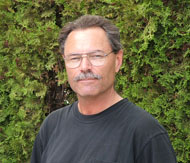
The interview was more like a tour with Rich as our guide. He took us from the Farmer’s Market to the gallery just up the street where he displays some of his small to medium sized sculptures. From there, we went just a few more blocks to his home where he does most of his stone jewelry and small size carving.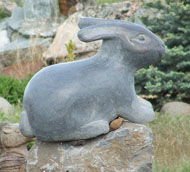
Later, Rich took us to a few of the homes in the county to photograph his work on site. Rich is skilled at developing a professional working relationship with the people who purchase his art. The buyers of his work were more than happy to open their homes to let us view his work. One couple, Joan Amby and Ruben Edinger, had purchased a female nude figure that they renamed ‘Cassandra’. The wife thought it unfair that the figure had no companion and commissioned Rich to carve a male counterpart. The sculptures, both hewn from marble, are now prominently displayed as an emblem of virility in an alcove wall in the couple’s bedroom.
Afterward, Rich and one of his carving students, Wendy Shaw, accompanied us for a late afternoon lunch at the famous college town hangout, The Tav, where we enjoyed the ‘Super Mother Burger’ and fries. The setting was perfect to continue our discussion of carving as the brick wall behind us had the names of customers that had gone before us hand-carved into each brick. Later that afternoon we toured the outdoor area where he works on his large pieces.
SC: Who inspires you when you work?
RB: I’ve always been inspired by the Japanese jade sculptors.
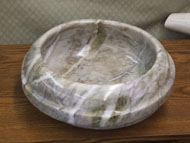
SC: Where do you typically obtain the stone you work from?
RB: Since a good portion of the readers of the newsletter are from Washington, they will recognize the name of the Skagit River from which the serpentine river boulder came that provided the material for the Black Swan.
DH: And the soapstone pieces?
RB: The seals, the salmon and the leaping trout are from Lake Wenatchee area.
DH: You find your brucite…?
RB: The brucite I used for the trio of salmon is from Stevens County near Spokane, Washington.
DH: And the marble?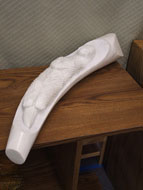
RB: The polar bear and elephant tusks are made from stone found at a marble quarry also in Stevens County, north of Spokane. The bowl is made from a different type of marble found at a quarry at Stevens Pass, near Seattle, Washington.
DH: Is the white marble quarry a closely held secret or does someone have a claim on it?
RB: A number of us sculptors have visited this quarry for years. This is one the Association has known about for a long time. I actually led a trip in there one time where we took out a few tons. As far as we know it’s not under claim of any sort and as you can see (he gestured to a picture of the quarry) there is still a lot of rock left there. What’s left is either the stuff you don’t want to carve or the stuff too big to haul out. Highway 25 literally goes through the front of the quarry. It’s about a hundred miles north of Spokane.
SC: How did you get started carving stone?
RB: I’ve been a rock hound and fossil collector since childhood, and when I moved to Washington in the early ‘70s I was already aware that the rock hounding was pretty good around here. After years of finding lots of nice rocks, bringing them home, putting them on the shelf and letting them collect dust, I got to wondering if there was something more I could do with it once I got it home.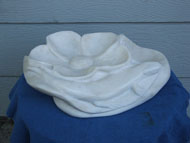
SC: What was your first “find?”
RB: It was September of 1979, and I was on a brief deer-hunting trip up in the northern edge of the county where there is a lot of serpentine. I found a little piece of serpentine that happens to be in the window of my living room. It was such a brilliant green, I wondered if it was jade. I took it to a rock shop, sliced it, sanded it and did a little scratch test on it. Seeing that this stone could easily be scratched with a knife, I decided to do a little carving on it. So, I did this outline of a rattlesnake head with its tongue stuck out as the first stone sculpture I ever did. I liked it! I got more little pieces of serpentine from the same area, and did little carvings out of them.
SC: And that gave you the ‘fever’?
RB: For the first several years that’s all I did, just little hand-held pieces out of stone. About 1987 or so, I started to do bigger pieces, coffee table pieces as they are called, in soapstone instead. I started getting soapstone from several different places, carved some seals out of it. Since I grew up on the coast of California, I’d seen a lot of sea lions as a kid, and of course they were really easy to carve, they are smooth and streamlined and lend themselves to sculpting and hand sanding afterward.
SC: Where did you get your first real break in the business?
RB: I started really producing and sold several of my first pieces through a gallery right here in Ellensburg. I got into it enough that I had work out in ten or twelve galleries at once. The galleries were as far north as British Columbia and south to Newport, Oregon, inland to Moses Lake and Wenatchee. I keep a logbook. In the period from August 1995 and August 1996 I made one hundred sculptures. Mostly soap stone, mostly for the tourist trade, coastal areas of Oregon and Washington. There are over 400 entries in my logbook to date.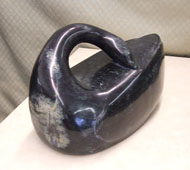
SC: Do you work on stone full time, or is it a hobby for you?
RB: I am your typical starving artist.
DH: What is your opinion regarding the drop in interest in sculpture in that market?
RB: Certainly a good question. A lot of us have been discussing it in depth. In Washington State in particular what’s frequently pointed out is the bottom dropping out of the high tech market and the dot-com failures. I don’t know how much of that had to do with it, maybe the economy in general, who knows. We’re talking the most disposable of the disposable income for stone sculpture at any price at all. It is certainly the first thing removed from anyone’s budget in an economical downturn.
DH: What have you done to ride out this tough time?
RB: Fortunately, there are few wealthy collectors around here, the people up at Liberty that had me doing the work on their property through most of the 90s. There’s also a collector here in the valley, he’s nuts for stone. He’s got a gorgeous place up at the west end of the valley. He built the house about ten years ago and trucked in about fifty tons of stone for landscaping. He’s had me out there a couple of times carving sculptures out of the stone he brought in and has also purchased several smaller sculptures from me.
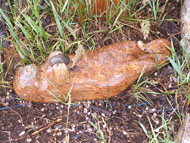
DH: What kind of tools do you use?
RB: I work in the back room of my home. What I’m showing you here (gesturing toward a plastic canopy covering what appears to be a modified electric grinding wheel) is a big plastic storage tub, which is half full of water. Sitting in the water is a framework, which supports an old maple cutting board, which is a mounting bench for a double spindle bench grinder. On the left hand spindle is a 7” in diameter, diamond sintered rock saw blade of the segmented variety. On the right hand spindle is once again a diamond sintered rock saw blade. They are 4” in diameter and I have gang-mounted eight of them together to make a ‘grind wheel’ with industrial diamonds through out. It’s great for shaping jewelry stones of any hardness. You can work agate, quartz crystal or even petrified wood, anything you want to.
DH: Why haven’t you patented this thing and become a millionaire?
RB: (Laughter)
It was time for the interview to be concluded. We were sad that our perfect day between typical Northwest rain showers had to come to an end; we experienced the endless talents of an accomplished sculptor and also had to part from a friend we made for life. Rich Baker is a quiet, unpretentious artist. His pride and enthusiasm in his work shows up in his sculpture, and his presence. Just don’t try to contact him via an email address… use snail mail!

